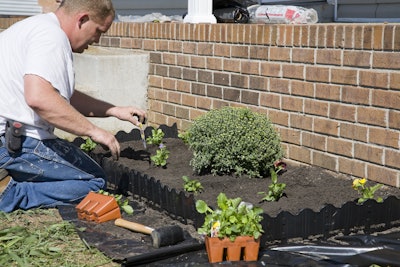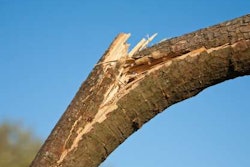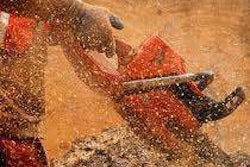 Lightweight landscape fabric works best in seasonal garden beds.
Lightweight landscape fabric works best in seasonal garden beds.Photo: Jobe’s
You could probably construct and fill planting beds with a spade, a little muscle and a lot of sweat, but if you want your profit margins and spine to stay healthy, a few good tools and well-chosen materials will help a lot. Here are just a few tools and materials to consider.
Bed edgers
Lee Campell of bed edger manufacturer Brown Products says that a bed edger can cut 30 feet of soil in a minute, but “to really be on your game and to be accurate, I think most landscapers are actually doing about 20 feet a minute. Still, you can imagine how much time and backache that saves over a spade.”
“What we used to do with spade shovels would take us from several hours to almost a full day to install a new edge for a planting bed, or to spruce up an existing edge,” agrees Matt Thompson of Thompson Landscaping in Henderson, North Carolina. “Now it takes us 15 to 30 minutes for each job and provides a perfect edge, which looks far better than if done by hand, in my opinion. Also, we promote natural trench edging instead of plastic edging material. Maintenance on this type of edging is simple and makes it easier to mow the turf. You can take your mower deck and run it on top of the edge, thus eliminating a lot of trimming work.”
Tillers
If you want to add soil or landscape mix to a bed for grade changes or swales, the subgrade should always be tilled to create good soil contact. A tiller is also handy when you want to enrich poor soil with amendments.
Soil amendments
“Biological amendments are especially helpful during times when a plant is stressed. They help plants make a healthy transition and establish roots when transplanted,” says Kristi Woods, research and development manager for Novozymes. Well-rotted compost can also help with plant health.
Landscape fabric
“Unless you’re trying to propagate plants by rhizomes, I can’t think when you would want to have a bed without landscape fabric,” says Larry Dewitt of Dewitt Company. “It’s better for the health of the soil, it saves water, it’s easy and it’s economical – about a dime a square foot. You can hand weed if you need therapy, but I’ve declared war on herbicides.”
Dewitt says the way to tell if a landscape fabric is a good one is to hold it up to the light. “If it doesn’t’ block at least 90 percent of the light, weeds may grow underneath, and even if they can’t break through, they’ll tent the fabric.” It should also be slightly permeable. “I know this sounds odd, but if you can breathe through it, so can the soil. And soil has to breathe.”









